Atomix - NYC Inventive Dining at the Top of its Game
Atomix Overview
Atomix is self described as “innovative cuisine” inspired by “Korean traditions and technique”. From my experience, this involves a combination of Korean dishes in a gastronomical modernist form or dishes with some Korean accents which highlight the main ingredient of the dish. Indeed, when contextualized to NYC, Atomix is likely the most innovative cuisine at this level of execution. Granted there are places like Honey Badger and the soon to be closed again Blanca, but those are for another too-long blog post. I’ve been to Atomix now 4 times, 3 of which were for the main menu and 1 was the bar tasting. Atomix isn’t really molecular gastronomy or an archival look at Korean food. It feels very different from the old Jungsik which was also modernized Korean food. To me, the best way I can describe it (which is no doubt colored by the dominant fine dining lens that is heavily eurocentric) is that Atomix is a new Nordic approach to Korean ingredients and dishes.
One last note. Something admirable about Atomix is they completely change the menu every few months. It’s not super unique among these types of restaurants but in New York, it’s a rarity. What makes it admirable is simply that it’s easy to rest on an acclaimed menu and continue to churn it out. Some of my absolute favorite restaurants in the world do this. But when you vary the menu so much, it guarantees increased variance in quality. As such, while every time I’ve gone to Atomix, it’s been an outstanding meal, the 2nd time was a notable decline from the first. I decided to go again because it was still excellent but also because I was hoping that it was just random sampling .5 stdevs below the average that caused my last meal there to lose its (coveted by no one) status as my favorite non-sushi restaurant in the city. Having returned, I can wholeheartedly declare that not only have they returned to that spot, but that they have cemented their place at number 1 in NYC for me. The following is a description of each dish I had and the (now refined) notes I took while having each dish.
1. Mussel with a 18 month Cheongguk Jang (Amuse Bouche 1)
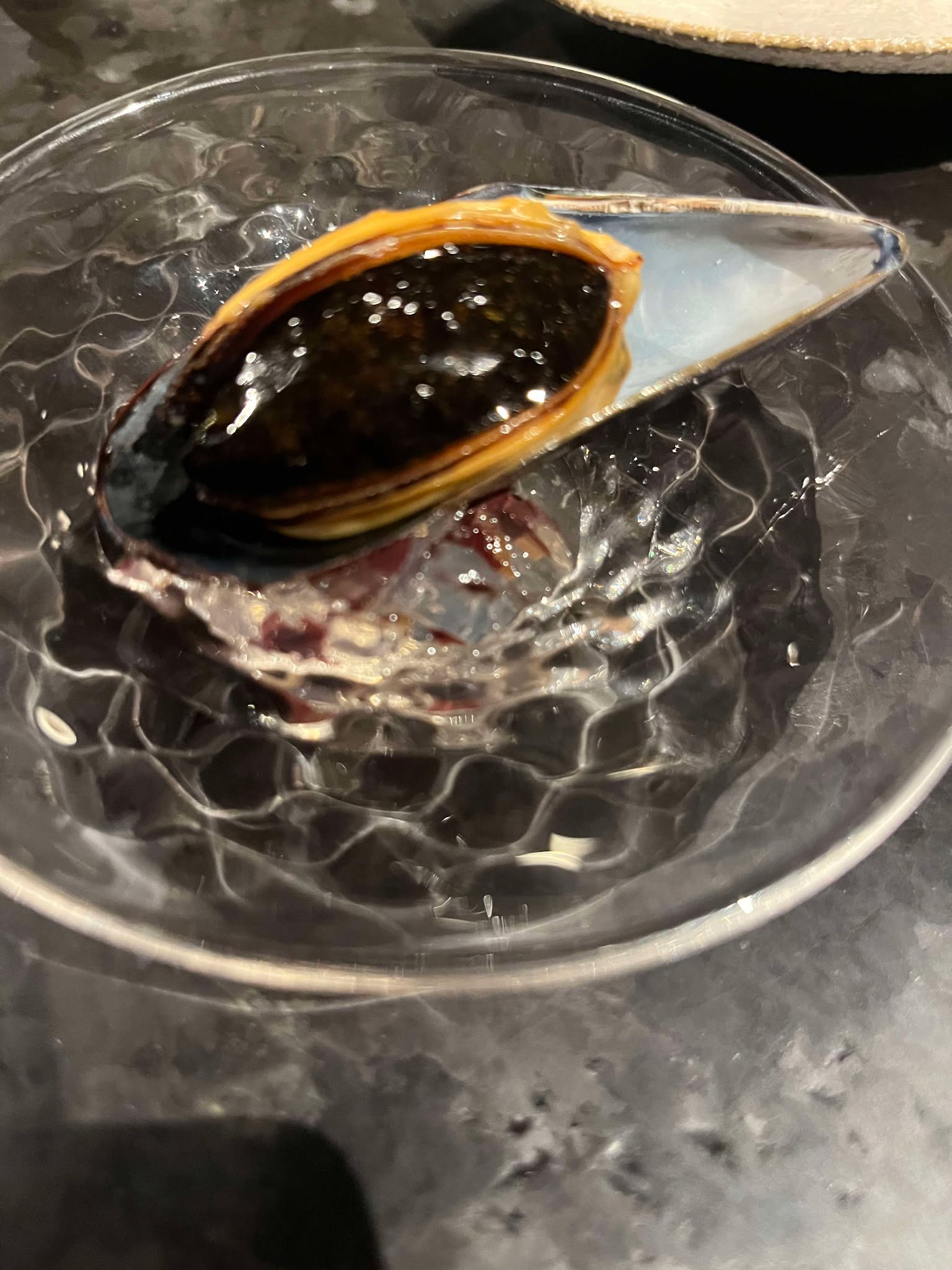
The meal started as many of these tasting menus do, with 3 amuse bouches that are 1-2 bites. This first one was a substantial mussel in an 18 month fermented soy bean paste that was more like a thinner sauce than the usual Cheongguk Jang. The mussel was meaty and like one of those heftier oysters from the Pacific. It was soft on the outside and a little grainy on the inside. Not in a necessarily unappealing way, but more just a variant texture that contrasts with when you are just breaking down the mussel. The flavor itself was an unsurprising burst of umami, especially when mixed with the soy sauce. What was surprising was that the Cheongguk Jang was more like a dashi than anything else. This certainly felt like one of the most Japanese accented dishes I’ve eaten at Atomix even if that was not intentional. All in all, it was a tasty first bite that was unique insofar as I don’t think I’ve ever had a bivalve with a concentrated soy component before.
2. Yangnyeom Lobster Jang. A piece of lobster in a nori shell with another Jang with some sort of spicy element added. On top is a gelatinized sliver of red pepper (Amuse Bouche 2)
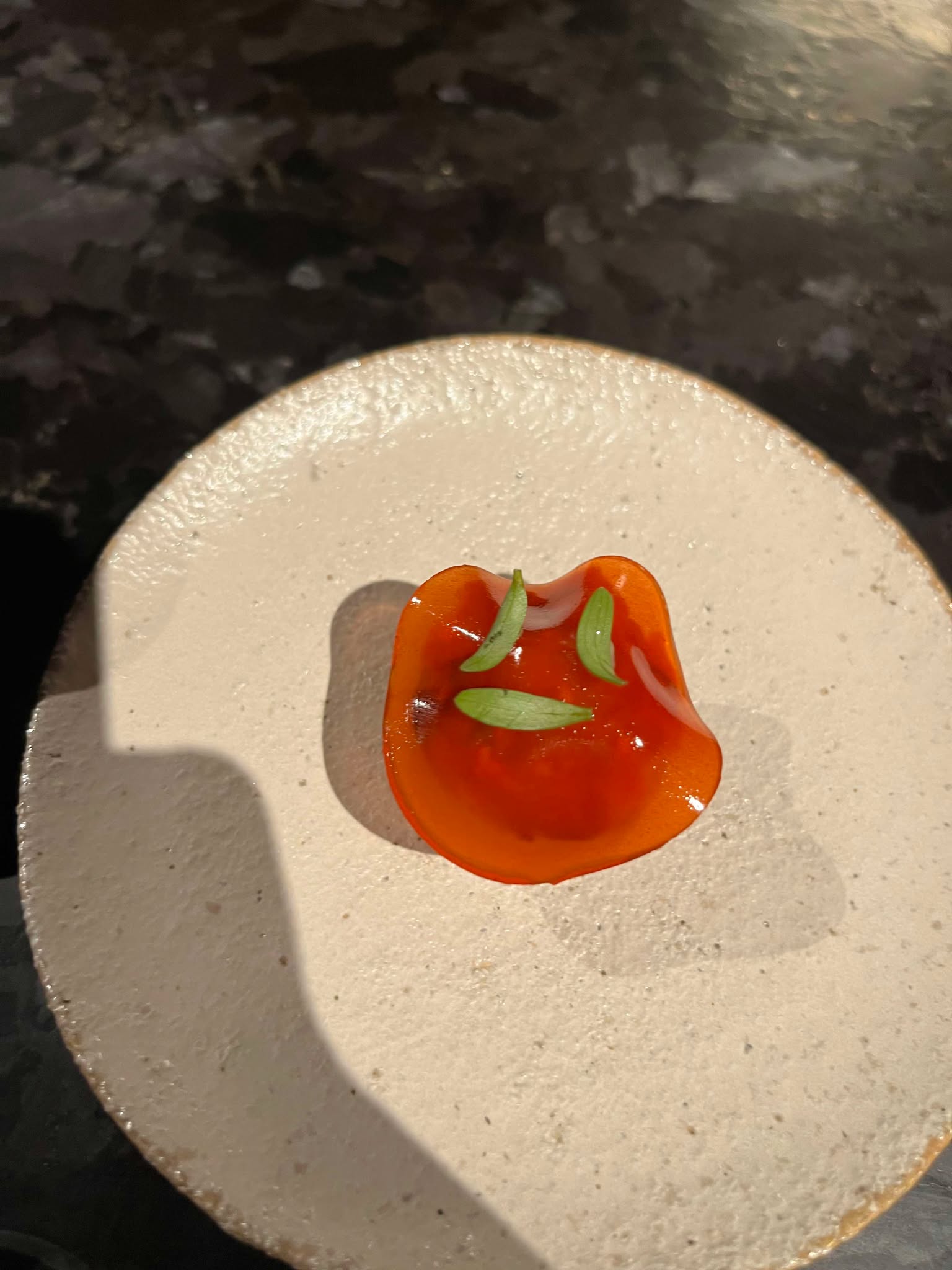
This was an improvement on the already good start with the last bite. Here, almost all of the salt came from the crispy nori shell which gives a classic textural contrast to the softer lobster meat. The Jang seemed to have some gochujang like flavor which kind of cut into the nuance of the specially fermented soy sauce they make but it provided a mouth-watering kick that paired really well with the red pepper that rounded the dish with a bright vegetal bite. The benefit of the gelatinized sliver is it helped mix into the dish but maintained just enough heterogeneity for you to be able to tell where each taste was coming from. Had it been a slice of the pepper, it would have added an unwanted crunch, and if it was just mixed in the sauce, it likely would've been overpowered by the gochujang and soy sauce.
3. Bbq unagi and yellowtail tartlet with a gochujang glaze (Amuse Bouche 3)
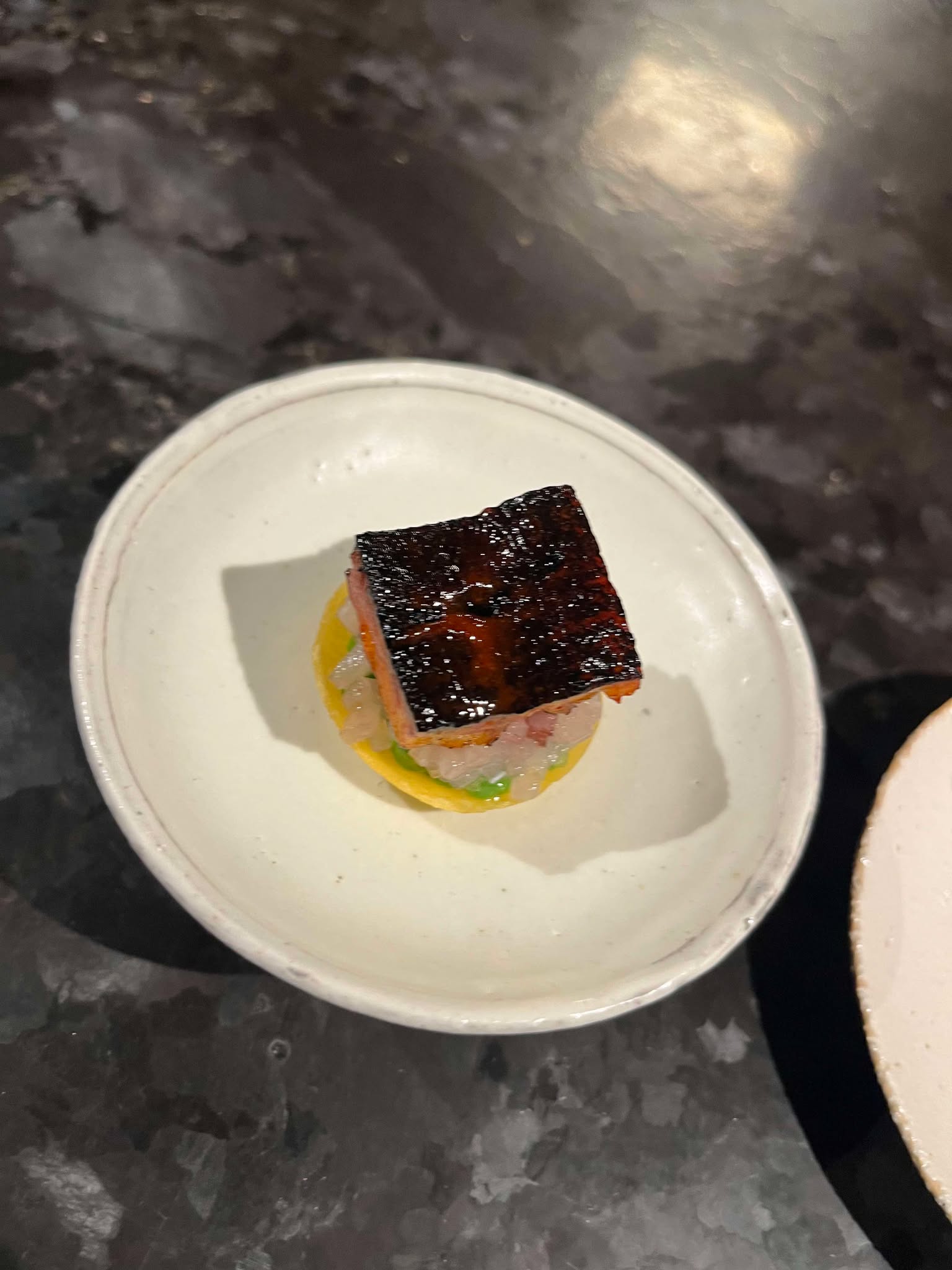
Of the 3 starting bites, this was clearly the best. Because it was barbequed, the eel added a lot of smoke to the leading sweet taste of the glaze. The more “sea breeze” type of umami from the yellowtail harmonized with the eel’s “darker” umami and helped create a more complex flavor altogether. The yellowtail melted in my mouth quickly, coating the meatier eel for the rest of the bite. The crisp from the tartlet was great as well but I think I’d have preferred if this was in the nori shell and the last dish had been on a tartlet. A very small gripe that I could even be wrong about, but just what I’d conjecture would’ve made both these dishes taste even better.
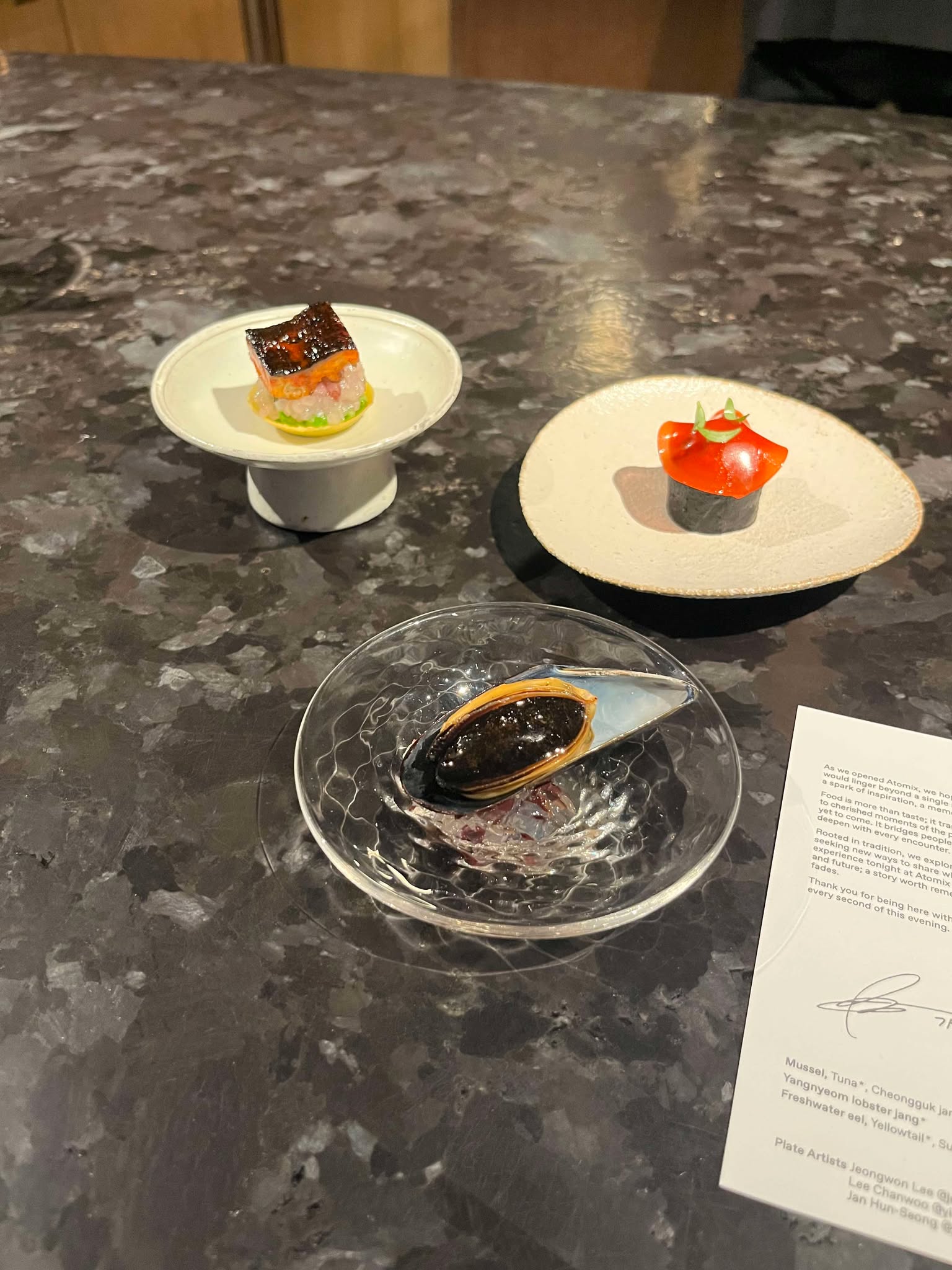
All Three Together
4. Striped beakfish with a garlicky “hot sauce”, a minari seaweed puree, pickled elderberries, and a minari ice flavored with dashi, jalapeno, and apple
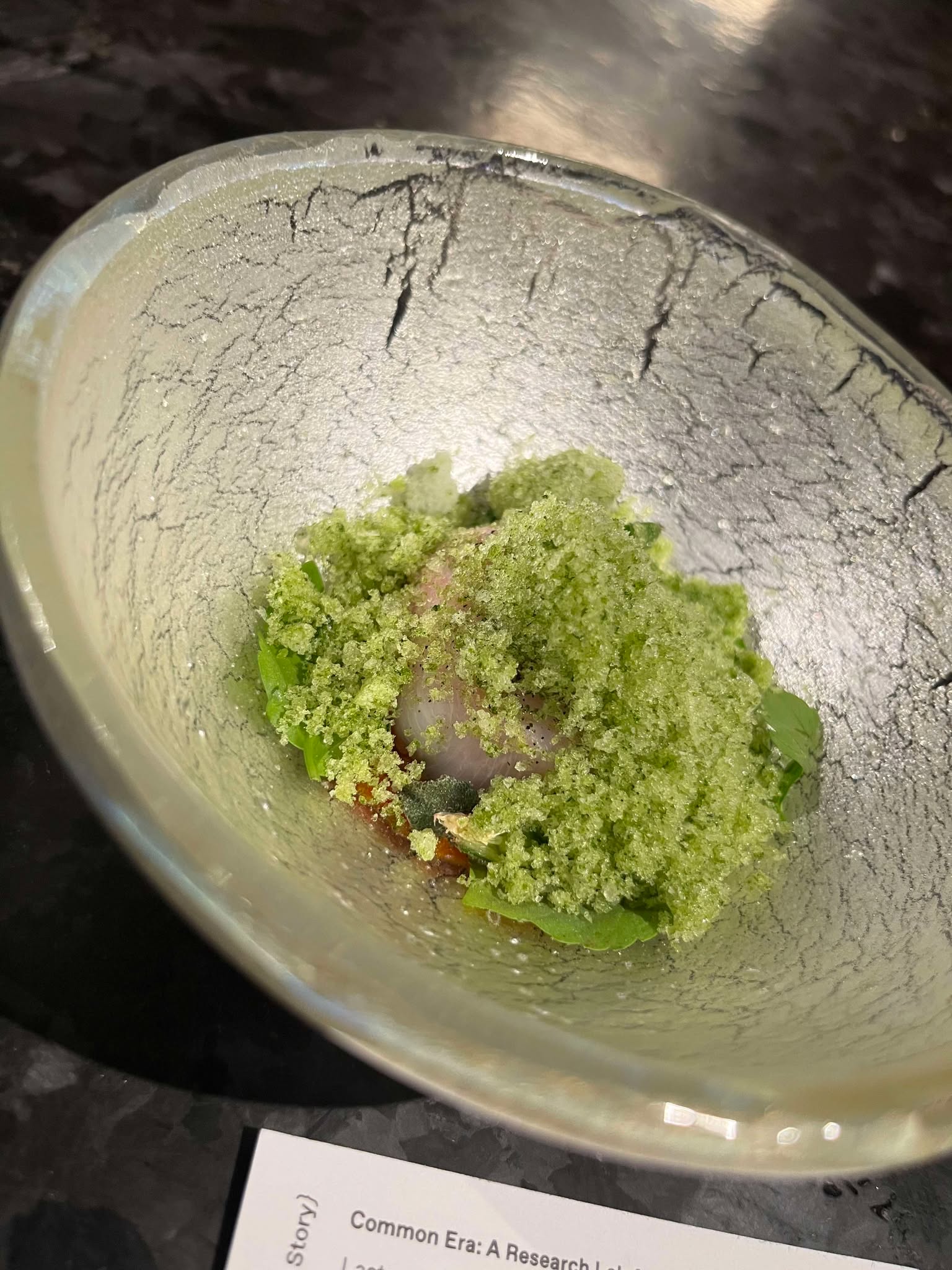
The fish had a tacky texture that quickly transitions into a pliant tenderness. It had a slight “wooden” flavor I only recognize as similar to earlier nigiri pieces at many edomae omakases. The sauce again had an enticing kick and tasted a little like the sesame dressing you get at japanese restaurants alongside the salad preceding a katsu curry (or an analogue thereof). The watercress in its multiple forms and the seaweed puree added what I could best describe as a dominant floral aura to the dish which was super cool and unique. The ice was a brilliant addition that helped keep the ingredients cold enough for all the delicate flavors in the dish to be kept intact. The jalapeno added an alternative spiciness that was peppery and mixed well with the deeper savory sauce on the dish. I don’t think I noticed the apple or pickled elderberries that much except with slight sparks of indeterminate sweetness but overall, it was a very ambitious dish that hit on almost every cylinder. I think casting the vegetal elements of the dish into elements that homogenize better, like the puree or the ice helped imbue those flavors into the bites with the fish and sauce as opposed to basically being a salad that can leave both elements feeling disjointed.
5. Black Banana (Fermented) on Monkfish Liver (Ankimo) with a perilla leaf sauce
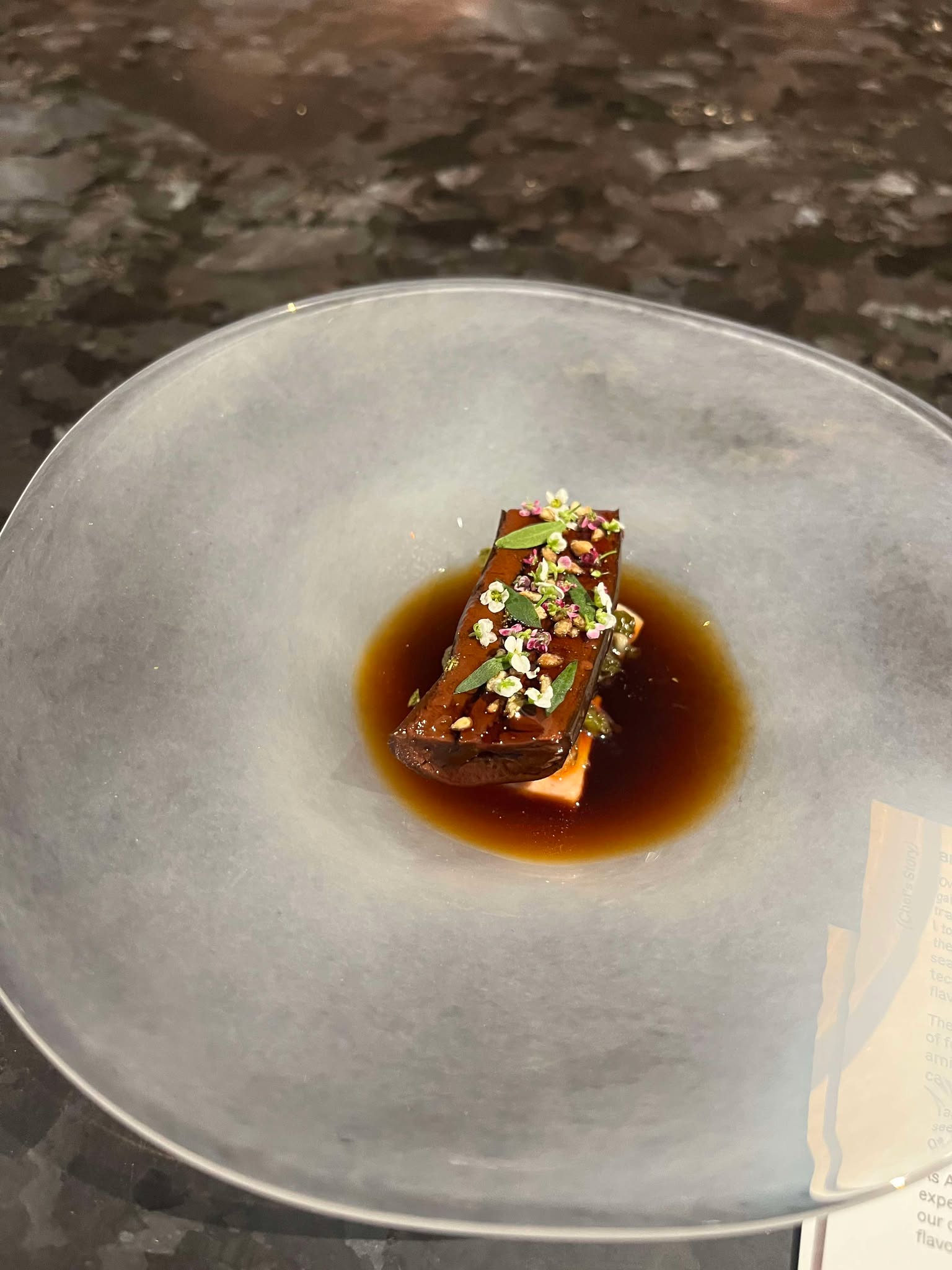
This is the best dish I’ve ever had from Atomix and one of the best dishes I’ve had just in general. I personally love ankimo, it’s like a more mineral-forward foie gras that isn’t quite a paste but more gelatinous. But once you bite into it, the liver immediately dissolves and coats the mouth like a foie gras paste does. In this case, the ankimo was transformed because of the black banana and sugar in the sauce. Black bananas are not something I’d ever had. Indeed, when I look it up, I can’t even find much about it. It’s effectively a fermented banana. In this case, it lost some of that brighter sweetness you get from a fresh banana, and it was replaced by a deep caramel flavor. This caramel flavor mixed with the perilla leaf sauce draped the ankimo developing a deep, nuanced toasted sweetness. It was like a gamey molasses, but in the best way. For the same reason Foie Gras pairs so well with certain jams, the black banana and ankimo formed a perfect symphony. The banana itself was soft but still chewable and when you get a bite of it and the ankimo, the ankimo coats the bite creating this perfect savory dessert bite. The sauce itself basically became a sweet syrup, but with such powerful flavors already, I’m not sure it should’ve been anything else. What was nice though is that the perilla leaf plus the fermentation added a hint of burnt yet herbaceous bitterness which helped cut the relatively sweet dish. My only wish is that the minty elements of the perilla leaf had come through more.
6. Soondubu Tofo Custard with Sweet Shrimp, Razor Clam, Mushrooms, nuruk chili oil, and a soybean and foie gras foam on top
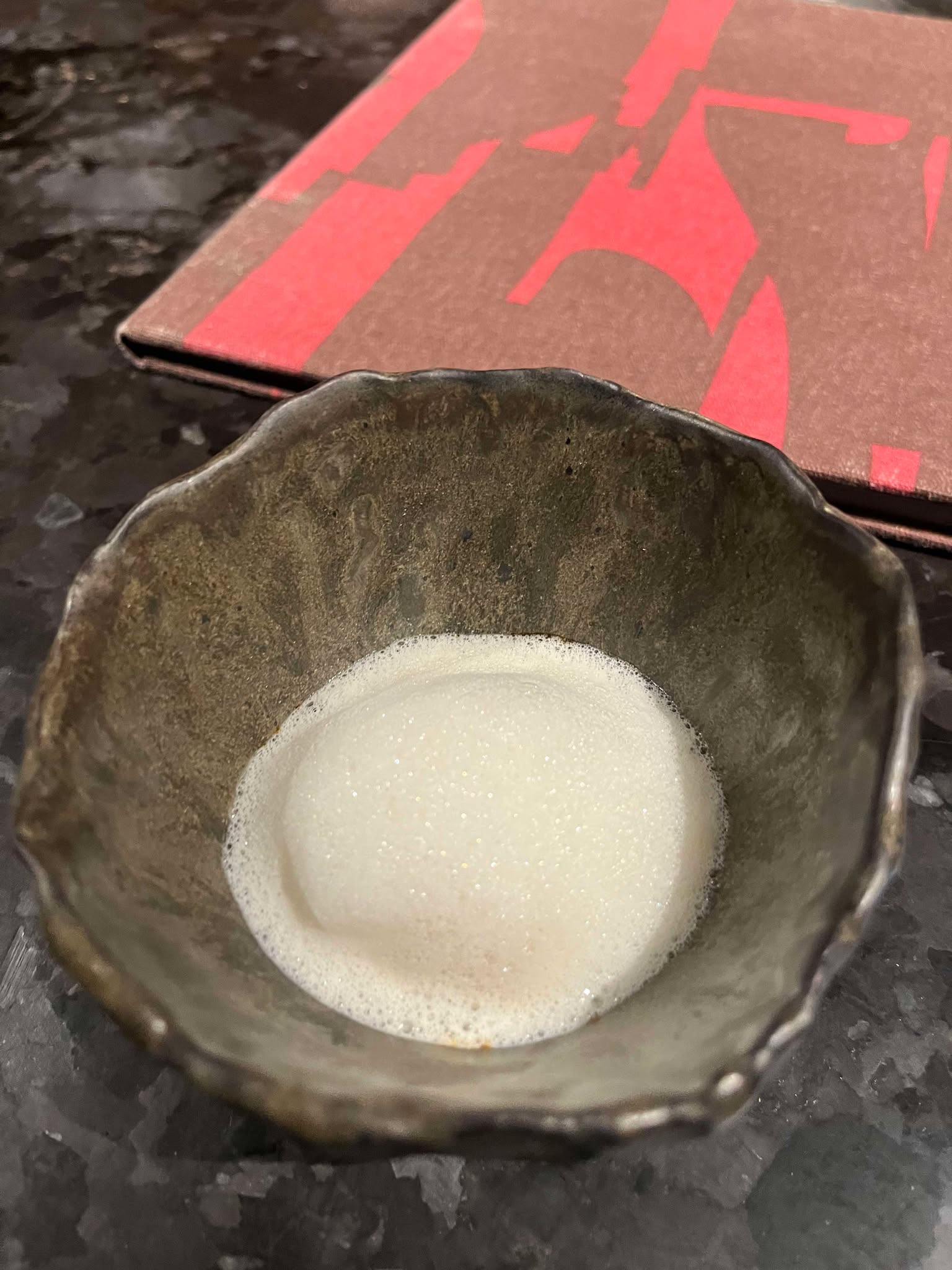
This was yet again another superb dish. This is quite similar to chawanmushi dishes at tasting menus in that its a savory custard with deluxe ingredients and a sauce. The soondubu was luxurious and creamy but not heavy because it’s a tofu custard. The best element here in a sea of delicious components was the chili oil. It was like a classic chili oil that you’d get at a taiwanese restaurant but sharper and more sesame-forward. That nuttiness suffused the bland tofu custard and popped on the shrimp which are juicy, tender, and have that classic crustacean sweetness. The razor clam and mushrooms were nice little accents in the dish that varied the flavor enough to see how the chili oil played with the other ingredients. That said, I don’t think they were particularly noteworthy. Unfortunately, the foie gras foam didn’t really articulate itself outside of being more like a soy sauce foam. It added the majority of the salt for the dish which was a great balancing note. But with foie gras, I want to taste that funkiness which was absent. That said, the plethora of other flavors more than made up for that.
7. Langoustine in a black truffle gel underneath a honeynut squash foam made with the stock from the langoustine
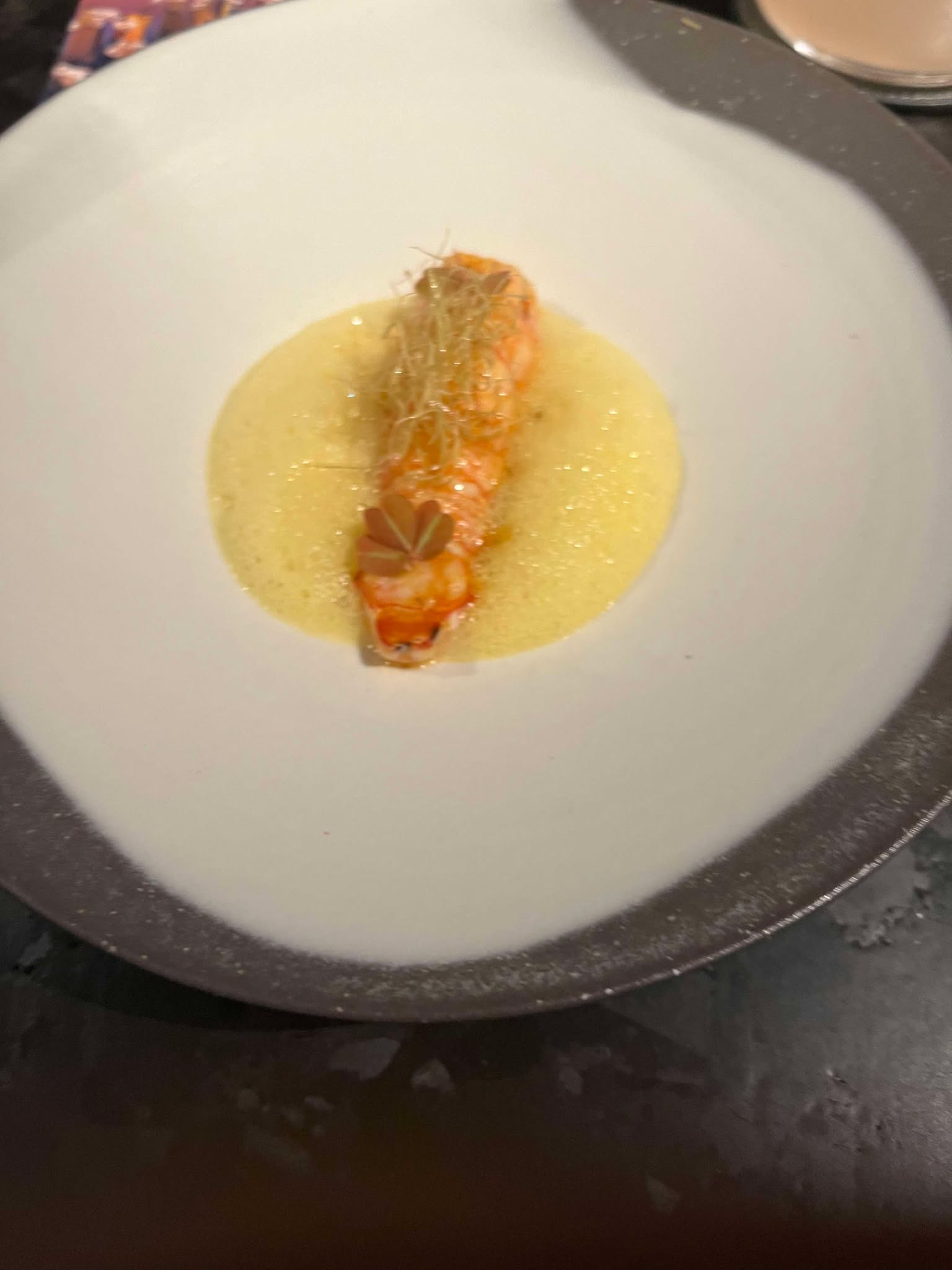
Once again, another delectable dish. Langoustine is another one of my favorite ingredients. It has a comparable texture to lobster but, for me, a little less fatty and less rich. Moreover, it has a brighter sweetness that’s a little more delicate than crab or lobster. As a result it has, in my experience, paired with various sauces much better because it doesn’t overwhelm the flavor composition. In this case, it was toothsome and then tender just as desired. The truffle jjang was a perfect and novel pairing because it added a grassy and even cheesy note to the dish which combined with the langoustine’s natural sweetness to create a very unique portrait of umami, funk, and sweetness. The foam also was slightly sweet but in all honesty, it was a little muted. Nevertheless, there was enough langoustine flavor as it stood, so no harm no foul. I think with a meat or more umami forward main, this dish could have been too savory but instead it oscillated between sweet + succulent and funky + grassy creating an addictive experience always waiting for the next peak of that wave.
8. Cherry Blossom Trout with roe in a makkgeoli sauce and anchovy oil. On the side is a littleneck clam in a perilla seed oil as a banchan
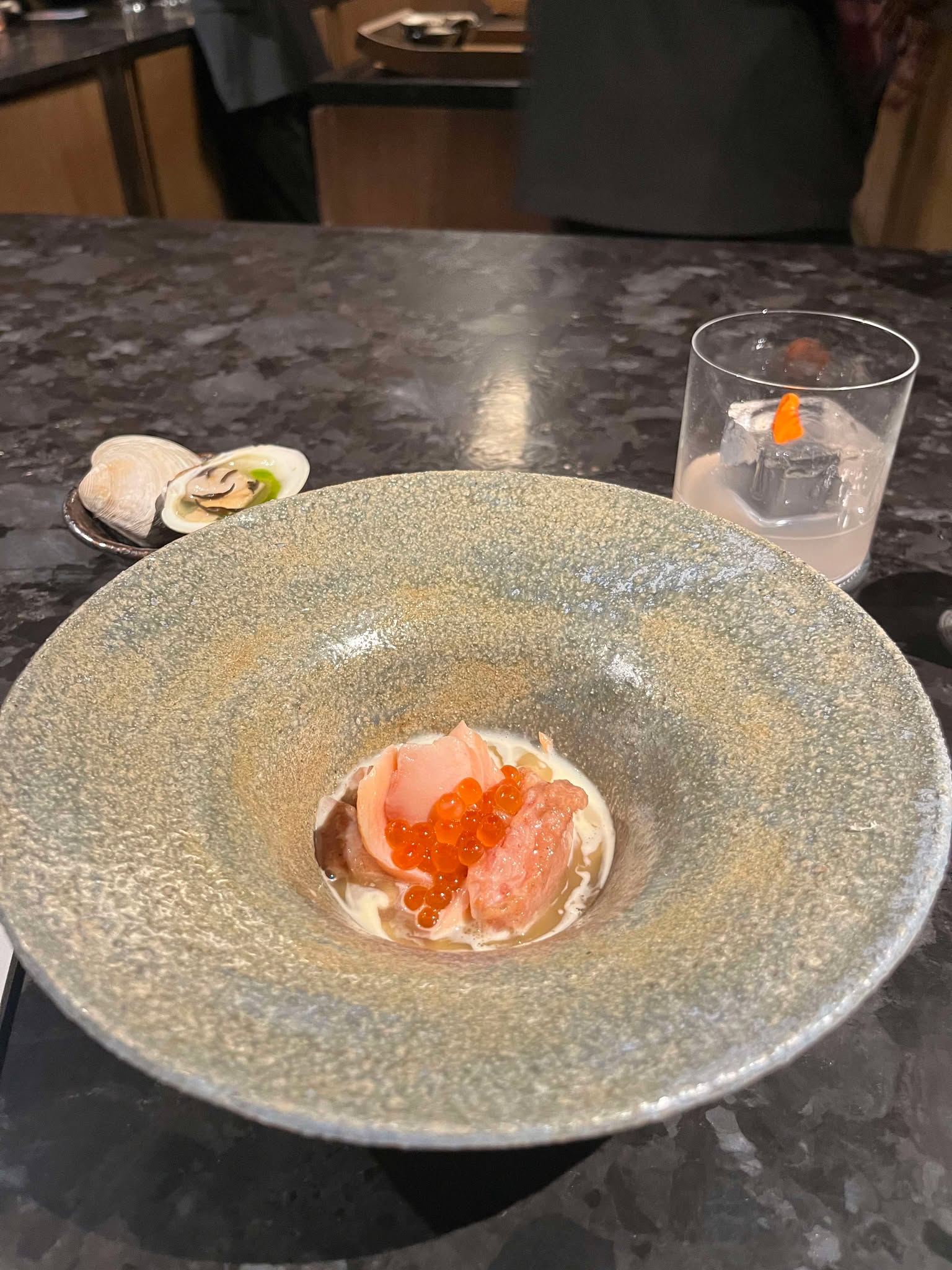
The trout was perhaps my favorite non-sushi trout dish I’ve ever had. It was super fatty, soft, and velvety. The trout accepted the umami forward anchovy sauce accentuating its inherent sea briney umami. The makkgeoli sauce was intriguing and scrumptious. They incorporated fish stock, shallot, and creme fraiche into the rice wine base which made a tangy and creamy tasting sauce that was not actually creamy in texture or substance. It felt like a clarified cream (though it wasn’t) which is great because I got all the flavor of a lactic-acidic creamy sauce but it was light. I wish the toasty elements of makkgeoli came through more, but it certainly added a unique acidic punch to the overall fatty dish which made what would usually be a very heavy dish extremely balanced and light. Again, the adept use of non-salt ingredients to supply the saltiness took this dish to the next level. The roe had a great texture and added the perfect amount of salinity to synergize with the rest of the ingredients. As for the banchan, while the perilla seed oil was interesting and peppery, the clam was bland and the two elements didn’t really mix all that well. I’d say it’s the only misstep of the meal.
9. Tilefish with a seaweed and jalapeno sauce and white asparagus underneath. On the side were buckwheat noodles with avocado, ginger, and a cold black truffle, sesame sauce
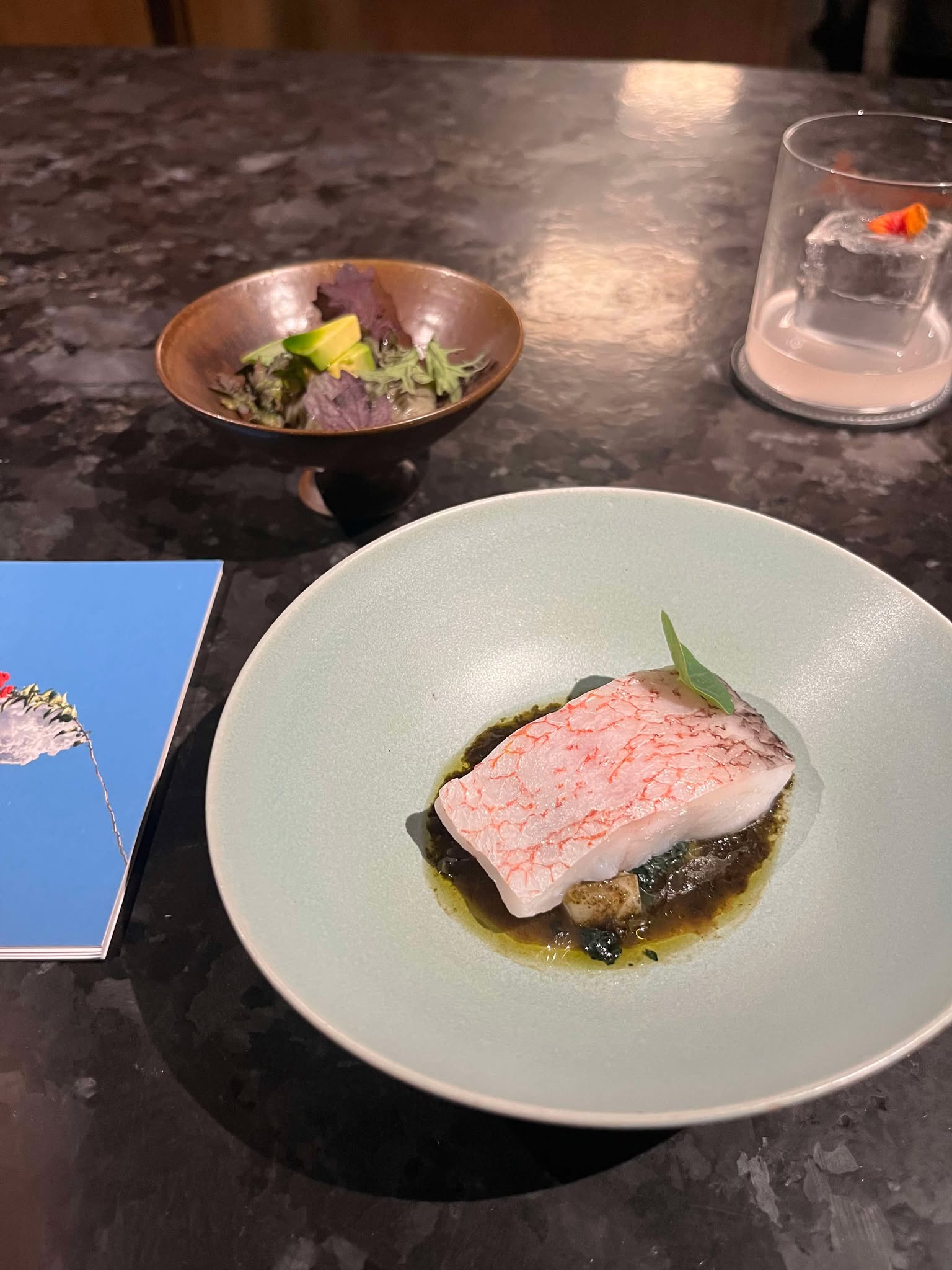
I tend to not be the biggest fan of dishes that are cooked fish in a nice sauce. It takes exceptional skill to get right, but I suspect I just don’t have the palate capable of discerning those specifics. It’s why, despite Le Bernardin objectively being a premier restaurant with some of the most talented chefs in the world, I don’t have it ranked as one of my top 10 restaurants in NYC. It’s still delicious, but it doesn’t quite tickle my fancy. That said, this dish absolutely did and was a perfect encapsulation of this genre of dish. The sauce was umami laden but more surprisingly was also sweet. Because of the seaweed and jalapeno it was very earthy and vegetal. The fish was cooked to the ideal texture and was not so cooked that I couldn’t discern the sea breeze flavor of it. The bites where I could get a healthy dose of the sauce and a piece of the fish were some of my favorite of the entire meal. Furthermore, the asparagus actually added a much needed textural contrast. The only issue is that because the sauce was more of like a thin oil with the seaweed element being suspended in it, it didn’t seep into the fish or coat it so mixing the two components together was quite an active effort. What really took this dish a level up though were the noodles. They were cold and refreshing and had that woody characteristic common in Soba. While they weren’t so special in flavor, they offered a really good pairing to the extremely savory and grassy main constituent of the plate.
10. Iberico Pork Belly with a caramel Doenjang and a Shishito Jang. On the side, a rice in an anchovy and iberico pork broth
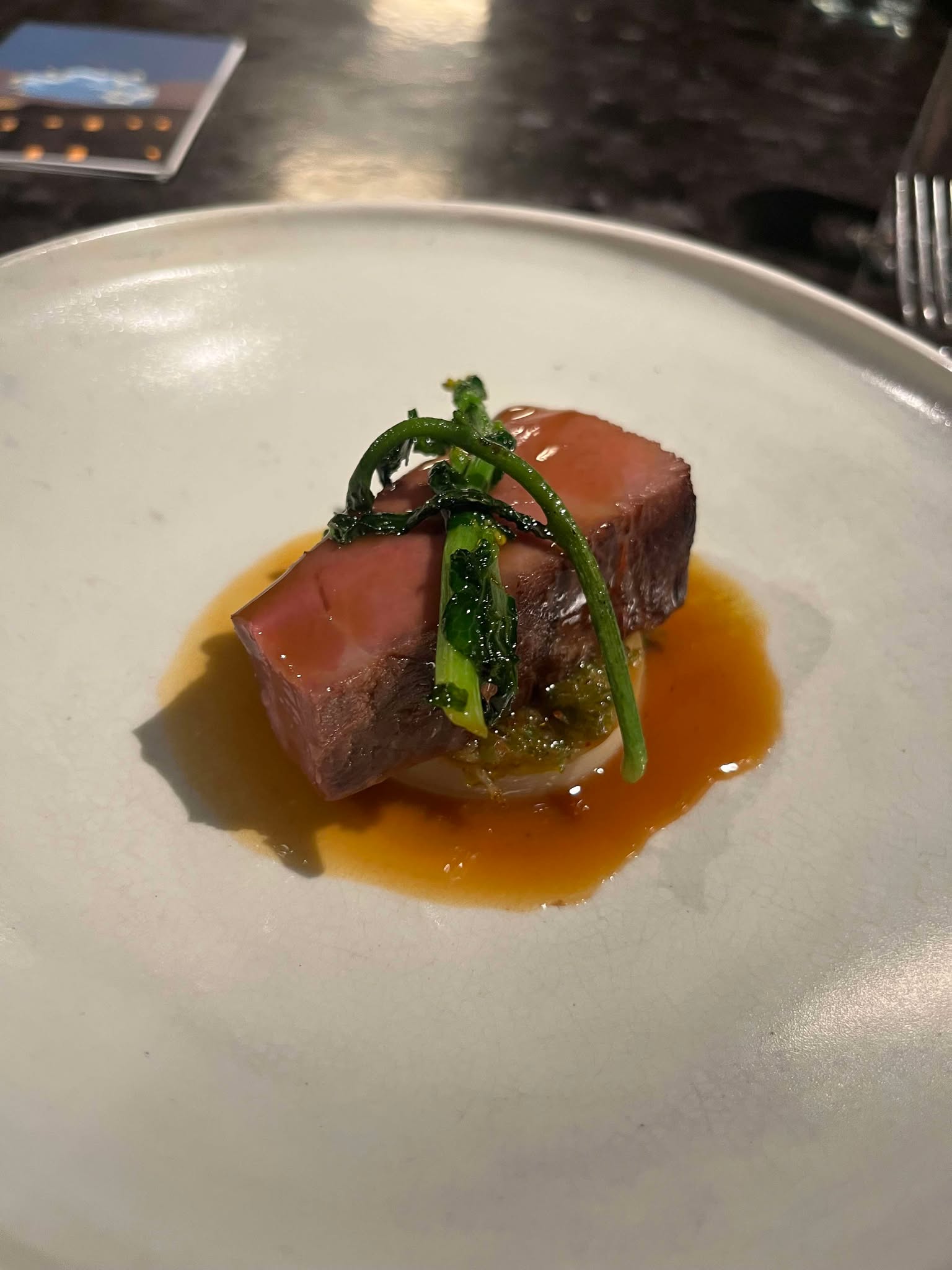
Unfortunately, for almost every tasting menu, this type of dish always ends up being my least favorite. Seemingly every tasting menu needs to finish their savory courses with a red meat in a dark meaty sauce. It’s not innately bad, but they all overlap in flavor and don’t really distinguish themselves among the crowd of this archetypical course. Indeed, that remains true here. While the caramel doenjang sounded interesting, the dish itself was basically just a fatty and tasty red meat in a “dark” flavored sauce. Now, the fact the sauce was a little sweeter than usual was exciting but not enough for me to feel all that compelled by this dish. It’s not really a fault of Atomix as it is with this everlasting tradition in tasting menus for as long as I’ve been going to fine dining restaurants. That said, the rice in the anchovy and pork broth was delicious. It was wholesome and satiating. It was the only reprieve in the meal from the highly technical entanglements of disparate and unique textures and flavors. Instead it was hearty, meaty, and the rice was toasty with each grain being turgid and heterogeneous.
11. Rhubarb Sorbet in a rhubarb compote and Schisandra berry sauce (Palate Cleanser)
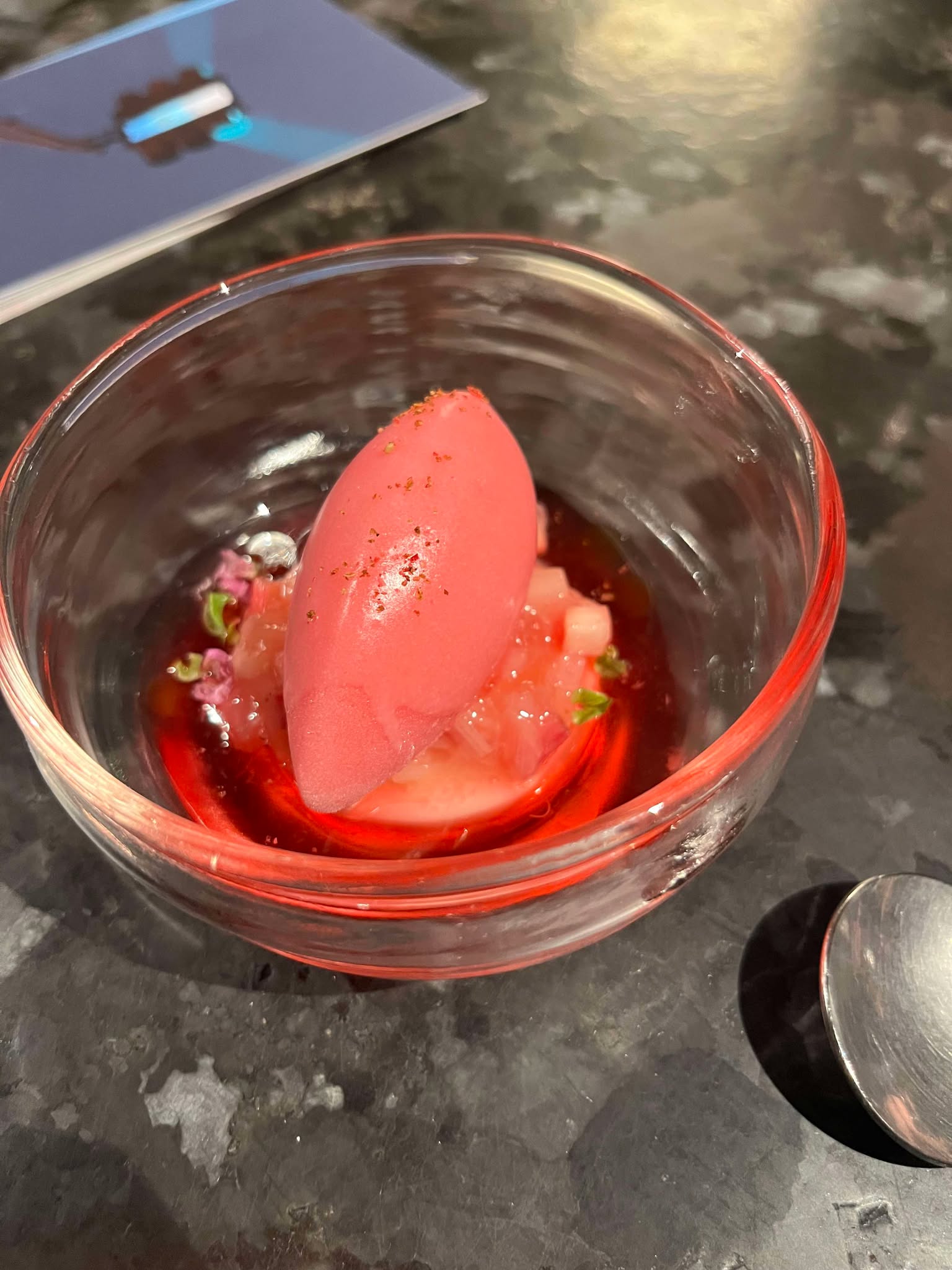
These palate cleansers tend to all overlap with one another at all these restaurants. Don’t get me wrong, they are delicious but they all hit the same beats. They are citrusy, sweet but not too sweet and very refreshing. That remained true here.
12. Almond Crumble, Cinnamon, ginger, and brown sugar custard, persimmon gel, and cinnamon-truffle caramel syrup on top. Finally covered with shaved black truffles
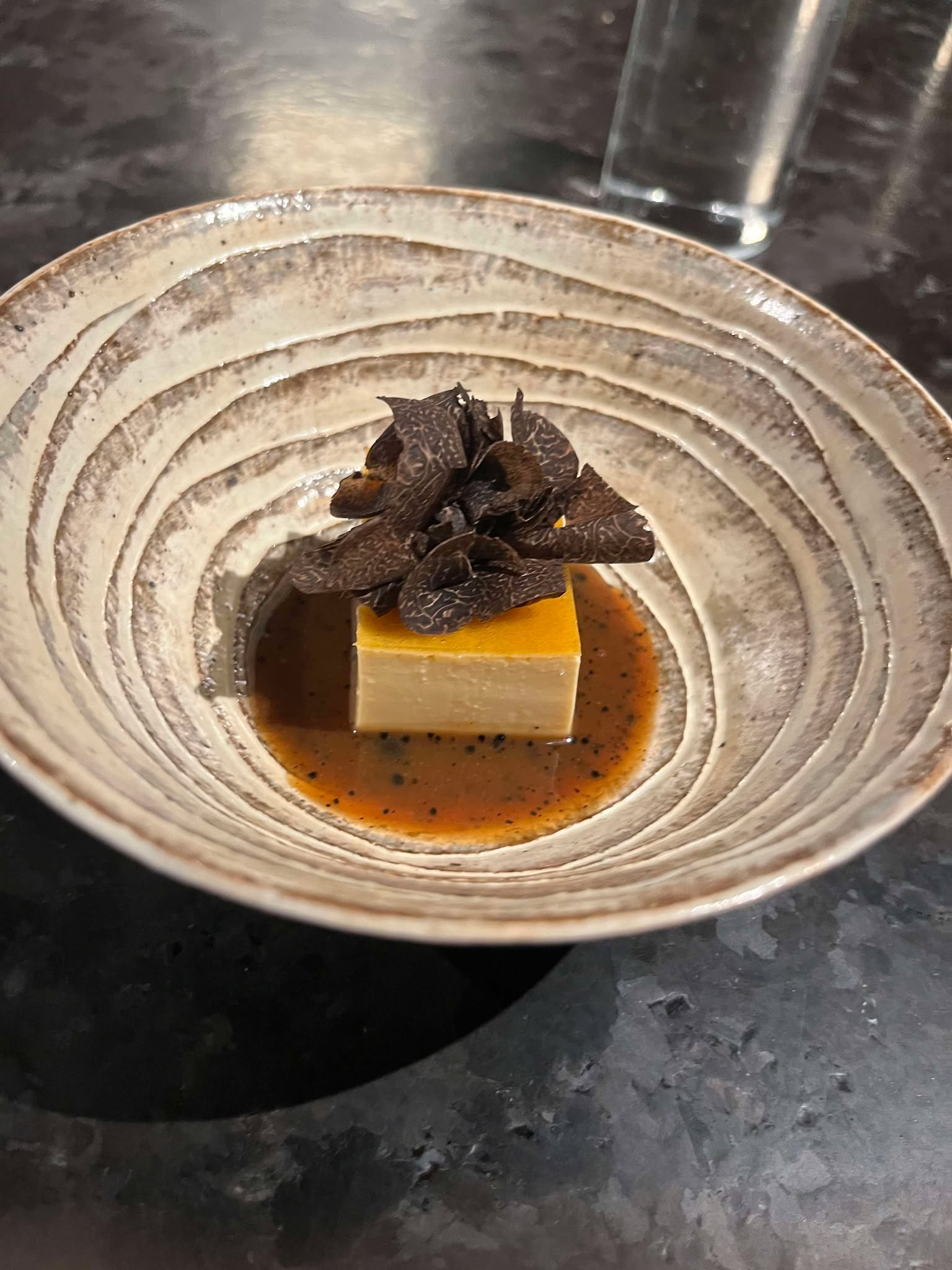
One thing Atomix has always done very well is desserts with savory elements. This is no exception. In fact, it’s the best dessert I’ve had at Atomix and one of the best desserts I’ve had all year. The custard and sauce kind of tasted like cinnamon toast crunch before you are confronted with the funky caramel syrup and earthy mushrooms. The flavor was deep and complex. It felt like a callback to the funky-sweet dyad of the black banana and ankimo dish. My only issue is that the sauce was a little too syrupy.
Final Thoughts
As I mentioned at the outset, and throughout this account, Atomix is clearly at the top of their game. They are putting out inventive creations predicated off Korean tradition but innovating to unlock flavor combinations that are not just uncommon, but in many cases, completely unexplored. It seems a major theme for this menu is playing with fermentation in its various forms and for my money, I don’t know somewhere in NYC doing it better. Granted I haven’t been to Meju, but Atomix and Meju’s missions are very different. More specifically though, Atomix excelled at playing with pairing umami with otherwise understood to be conflicting flavors. Whether it was the Langoustine and truffle sauce, the Sujeonggwa dessert with a funky caramel, or the ankimo with black banana, Atomix opened my palate to a unique articulation of the exemplary marriage between savory and sweet. Moreover, I love that they have so many dishes with a real spicy kick and an actual fidelity to heat that most even Asian inspired tasting menus eliminate. Because of Atomix’s openness to potentially divisive flavor pairings, they are able to create a menu unlike any other in New York. Every minor gripe I had were all inconsequential when I think about how ambitious the menu is and how well they do in really trying to innovate in this branch of gastronomy.